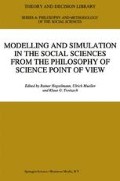Abstract
This paper aims at a logical reconstruction of some different approaches to modeling processes of self-organization in the social sciences, and it uses these approaches as examples which are to show that computer simulation supports structuralist reconstruction of theories if it is done in a certain way. In contrast especially to Troitzsch (1992) we do not concentrate on a specific theory of attitude change although we shall take the axiomatizations carried out there as but one example of a theory of self-organization.
Access this chapter
Tax calculation will be finalised at checkout
Purchases are for personal use only
Preview
Unable to display preview. Download preview PDF.
References
Drogoul, A., and Ferber, J. (1994) Multi-agent simulation as a tool for studying emergent processes in societies. Doran, J., and Gilbert, G.N., eds. Simulating Societies: the Computer Simulation of Social Phenomena, pp. 127–142. University of London College Press, London.
Glance, N.S., and Huberman, B.A. (1993) The outbreak of cooperation. Journal of Mathematical Sociology, 17 (4), pp. 281–302.
Haken, H. (1988) Information and Self-Organization. A Macroscopic Approach to Complex Systems. Springer Series in Synergetics, vol. 40. Springer, Berlin, Heidelberg, New York.
Hayek, F.A. (1942) Scientism and the study of society. Economica, 9, pp. 267–291; 10, pp. 34–63; 11, pp. 27–39.
Hegselmann, R. (1995) Experimentelle Moralphilosophie. Computersimulationen zu Klassen, Cliquen und Solidarität. Hegselmann, R., and Peitgen, H.O., eds., Ordnung und Chaos in Natur und Gesellschaft. Hölder-Pichler-Tempski, Wien, in press.
Helbing, D. (1992) A mathematical model for attitude formation by pair interactions. Behavioral Science, 37, pp. 190–214.
Helbing, D. (1992). A mathematical model for behavioral changes by pair interactions and its relation to game theory. Angewandte Sozialforschung, 17, pp. 179–194.
Herlitzius, L. (1990) Schätzung nicht-normaler Wahrscheinlichkeitsdichtefunktionen. Gladitz, J., and Troitzsch, K.G., eds., Computer Aided Sociological Research. Proceedings of the Workshop “Computer Aided Sociological Research” (CASOR’89), Holzhau/DDR, October 2nd-6th, 1989. Akademie-Verlag, Berlin, pp. 379–396.
Homans, G.C. (1950) The Human Group. Harpers, New York.
Holling, H., and Suck, R. (1989) Interruption of action and stress. Westmeyer, H., ed., Psychological Theories from a Structuralist Point of View. Springer, Berlin, Heidelberg, New York, pp. 187–202.
Kirk, J., and Coleman, J.S. (1967) Formalisierung und Simulation von Interaktionen in einer Drei-Personen-Gruppe. Mayntz, R., ed., Formalisierte Modelle in der Soziologie, volume 39 of Soziologische Texte. Luchterhand, Neuwied, pp. 169–190.
Klee, A., and Troitzsch, K.G. (1993) Chaotic behaviour in social systems: Modelling with GEMM. Troitzsch, K.G., ed., Catastrophe, Chaos, and Self-Organization in Social Systems. Invited Papers of a Seminar Series on Catastrophic Phenomena in Soviet Society and Self-Organized Behaviour of Social Systems Held at the Institute of Sociology of the Academy of Sciences of the Ukrainian Republic, Kiev, September 4 to 11, 1992. Universität Koblenz-Landau, Koblenz, pp. 81–104.
Schnell, R. (1992) Artificial intelligence, computer simulation and theory construction. Faulbaum, F., ed., SoftStat ’91. Advances in Statistical Software 3, Gustav Fischer, Stuttgart, Jena, New York, pp. 335–342.
Simon, H.A. (1957) Models of Man, Social and Rational. Mathematical Essays on Rational Human Behavior in a Social Setting. Wiley, New York.
Troitzsch, K.G. (1987) Bürgerperzeptionen und Legitimierung. Anwendung eines formalen Modells des Legitimations-/Legitimierungsprozesses auf Wählereinstellungen und Wählerverhalten im Kontext der Bundestagswahl 1980. Lang, Frankfurt, Bern, New York.
Troitzsch, K.G. (1990) Self-organisation in social systems. Gladitz, J., and Troitzsch, K.G., eds., Computer Aided Sociological Research. Proceedings of the Workshop “Computer Aided Sociological Research” (CASOR’89), Holzhau/DDR, October 2nd-6th, 1989. Akademie-Verlag, Berlin, pp. 353–377.
Troitzsch, K. G. (1991) A comparison of some models of processes of self-organization. Werner Ebeling, Manfred Peschel, and Wolfgang Weidlich, editors, Models of SelfOrganization in Complex Systems. Akademie-Verlag, Berlin, pp. 106–116.
Troitzsch, K.G. (1992) Structuralist theory reconstruction and specification of simulation models in the social sciences. Westmeyer, H., ed., The Structuralist Program in Psychology: Foundations and Applications. Hogrefe & Huber, Seattle, Toronto, Bern, Göttingen, pp. 71–86.
Weidlich, W., and Haag, G. (1983) Concepts and Models of a Quantitative Sociology. The Dynamics of Interacting Populations. Springer Series in Synergetics, vol. 14. Springer, Berlin, Heidelberg, New York.
Wurster, B. (1988) Periodic cell communication. Mario Markus, Stefan C. Müller, and Grégoire Nicolis, editors, From Chemical to Biological Organization, Springer, Berlin, Heidelberg, New York, Paris, pp. 255–260.
Author information
Authors and Affiliations
Editor information
Editors and Affiliations
Rights and permissions
Copyright information
© 1996 Springer Science+Business Media Dordrecht
About this chapter
Cite this chapter
Troitzsch, K.G. (1996). Simulation and Structuralism. In: Hegselmann, R., Mueller, U., Troitzsch, K.G. (eds) Modelling and Simulation in the Social Sciences from the Philosophy of Science Point of View. Theory and Decision Library, vol 23. Springer, Dordrecht. https://doi.org/10.1007/978-94-015-8686-3_11
Download citation
DOI: https://doi.org/10.1007/978-94-015-8686-3_11
Publisher Name: Springer, Dordrecht
Print ISBN: 978-90-481-4722-9
Online ISBN: 978-94-015-8686-3
eBook Packages: Springer Book Archive

